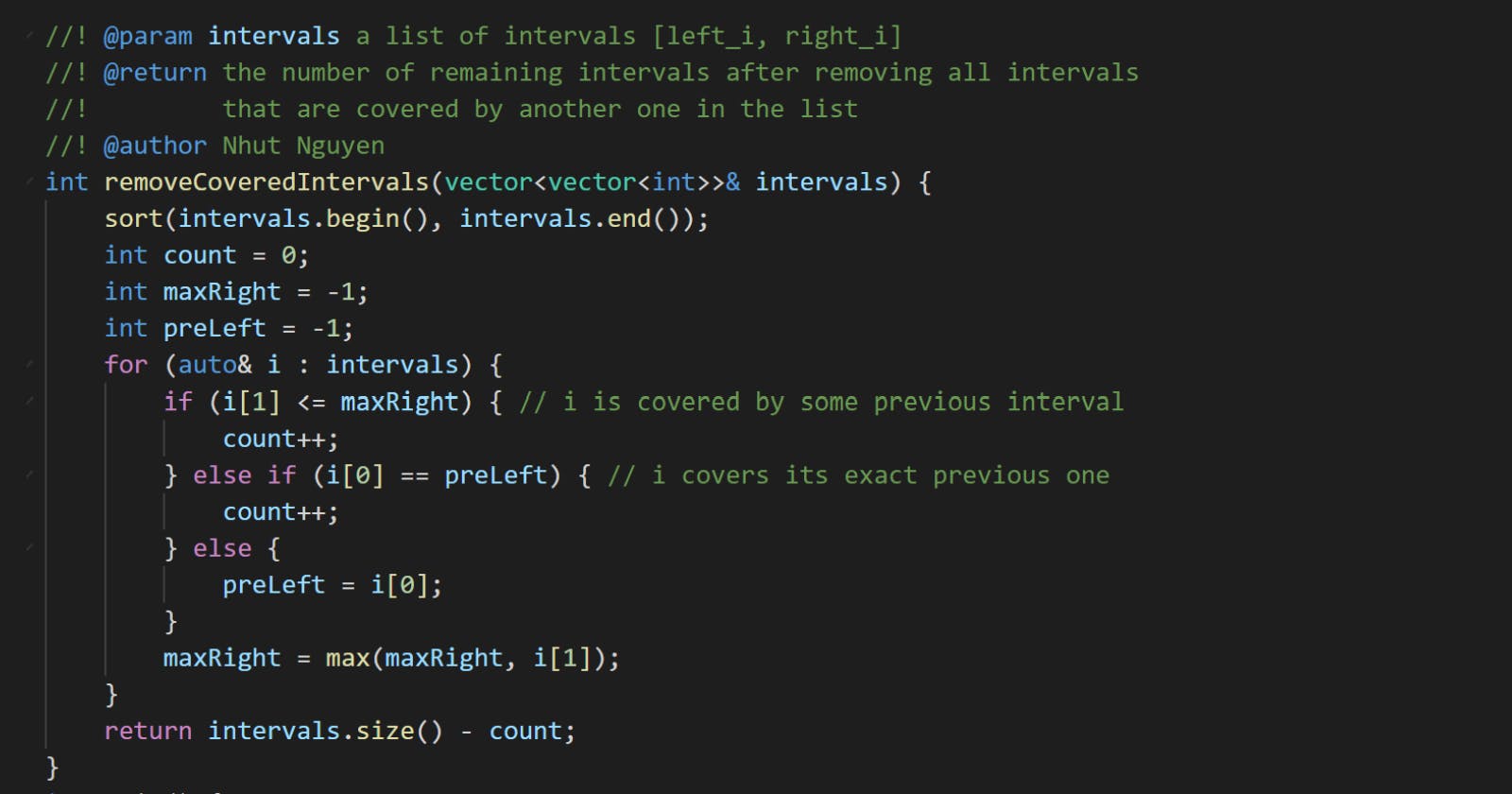Problem statement
Given an array intervals where intervals[i] = [li, ri] represent the interval [li, ri), remove all intervals that are covered by another interval in the list.
The interval [a, b) is covered by the interval [c, d) if and only if c <= a and b <= d.
Return the number of remaining intervals.
Example 1
Input: intervals = [[1,4],[3,6],[2,8]]
Output: 2
Explanation: Interval [3,6] is covered by [2,8], therefore it is removed.
Example 2
Input: intervals = [[1,4],[2,3]]
Output: 1
Constraints
1 <= intervals.length <= 1000.intervals[i].length == 2.0 <= li <= ri <= 10^5.All the given intervals are unique.
Solution 1: Bruteforce
For each interval i, find if any other interval j such that j covers i or i covers j then remove the smaller one from intervals.
Example 1
For intervals = [[1,4],[3,6],[2,8]].
With interval
i = [1,4], there is no other intervaljsuch that coversiorjcoversi.With interval
i = [3,6], there is intervalj = [2,8]converingi. Remove[3,6]fromintervals.
Final intervals = [[1,4],[2,8]].
Code
#include <vector>
#include <iostream>
using namespace std;
inline bool isCovered(vector<int>& i, vector<int>& j) {
return j[0] <= i[0] && i[1] <= j[1];
}
int removeCoveredIntervals(vector<vector<int>>& intervals) {
int i = 0;
while (i < intervals.size() - 1) {
int j = i + 1;
bool erase_i = false;
while (j < intervals.size()) {
if (isCovered(intervals[i], intervals[j])) {
intervals.erase(intervals.begin() + i);
erase_i = true;
break;
} else if (isCovered(intervals[j], intervals[i])) {
intervals.erase(intervals.begin() + j);
} else {
j++;
}
}
if (!erase_i) {
i++;
}
}
return intervals.size();
}
int main() {
vector<vector<int>> intervals{{1,4},{3,6},{2,8}};
cout << removeCoveredIntervals(intervals) << endl;
intervals = {{1,4},{2,3}};
cout << removeCoveredIntervals(intervals) << endl;
}
Output:
2
1
Complexity
Runtime:
O(N^3), whereN = intervals.length.Extra space:
O(1).
Solution 2: Using dictionary order
You might know how to look up words in a dictionary.
The word apple appears before candy in the dictionary because the starting letter a of apple appears before c of candy in the English alphabet.
And apple appears after animal since the next letter p appears after n.
The C++ Standard Library uses that dictionary order to compare two std::vectors.
Example 1
Rewriting intervals = [[1,4],[3,6],[2,8]] in dictionary order you get intervals = [[1,4],[2,8],[3,6]]. In this order, the left bounds of the intervals are sorted first.
If intervals is sorted like that, you can avoid bruteforce in Solution 1 by a simpler algorithm.
Check if each interval i covers or is covered by some of the previous ones.
Remember that the left bound of interval i is always bigger than or equal to all left bounds of the previous ones. So,
iis covered by some previous interval if the right bound ofiis less than some of the right bounds before.Otherwise
ican only cover its exact previous one that has the same left bound.
Code
#include <vector>
#include <iostream>
#include <algorithm>
using namespace std;
int removeCoveredIntervals(vector<vector<int>>& intervals) {
sort(intervals.begin(), intervals.end());
int count = 0;
int maxRight = -1;
int preLeft = -1;
for (auto& i : intervals) {
if (i[1] <= maxRight) { // i is covered by some previous interval
count++;
} else if (i[0] == preLeft) { // i covers its exact previous one
count++;
} else {
preLeft = i[0];
}
maxRight = max(maxRight, i[1]);
}
return intervals.size() - count;
}
int main() {
vector<vector<int>> intervals{{1,4},{3,6},{2,8}};
cout << removeCoveredIntervals(intervals) << endl;
intervals = {{1,4},{2,3}};
cout << removeCoveredIntervals(intervals) << endl;
}
Output:
2
1
Complexity
Runtime:
O(NlogN), whereN = intervals.length.Extra space:
O(1).
Key takeaway
- Two
std::vectors can be compared using the dictionary order.
Thanks for reading. Feel free to share your thought about my content.
What is your approach? The problem was picked from leetcode.com. You can submit your solution in any programming language and check the performance.

